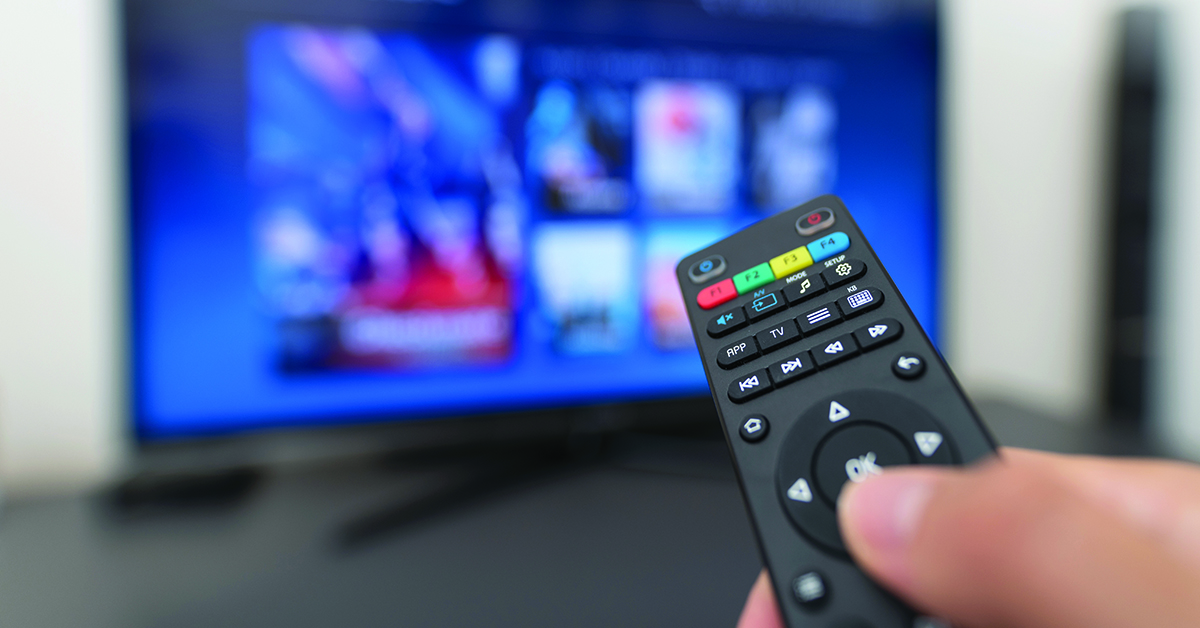
While you were streaming: Smoking on demand
Smoking on the small screen has gone from common to nearly unavoidable, as popular programs like “Stranger Things,” “Orange Is the New Black” and “Modern Family” increasingly show images of tobacco and portray characters who smoke.
The popularity of streaming combined with the pervasive rise of smoking in episodic content points to an emerging threat to a new generation of Young Americans. Truth Initiative® first reported on this issue in 2018 with the study “While You Were Streaming: Tobacco Use Sees a Renormalization in On-Demand Digital Content, Diluting Progress in Broadcast & Theaters.” In the year since then, the danger has only grown.
Our prior analysis found that Netflix programs depicted more smoking imagery than broadcast shows. In 2019, Truth Initiative researchers re-analyzed tobacco content in the same episodic programming most popular with young people between 15 and 24 years old and found that Netflix once again topped the list with nearly triple the number of tobacco instances (866) compared with the prior year (299). Broadcast/cable programming showed nearly two and a half times more tobacco imagery than the previous year. Overall, 92% of the shows analyzed contained images of tobacco in the 2016-17 season, up from 79% in the 2015-16 season.
Based on estimated viewership of these programs, results suggest that approximately 28 million young people were exposed to tobacco through television and streaming programs in these most popular shows alone. That exposure is a significant public health concern because viewing tobacco use in on-screen entertainment media is a critical factor associated with young people starting to smoke. The U.S. surgeon general found that those with higher levels of exposure to tobacco use in movies are twice as likely to smoke compared with those with less exposure.1 Further, analysis of peer-reviewed studies estimates that exposure to tobacco use in movies is responsible for 37% of smoking initiation among young smokers.
While smoking in TV programs has not been studied as extensively as tobacco imagery in movies, it is reasonable to conclude a similar harmful impact is possible. The rise of online streaming platforms has also created more opportunities for exposure to tobacco imagery. According to the Pew Research Center, 61% of young adults report online streaming services as the primary mechanism for viewing episodic programming. It is also possible that the ability to watch multiple episodes at a time (“binge watching”) may even intensify the impact of exposure.
How researchers selected and analyzed the shows
Truth Initiative researchers identified the most popular episodic programs through an online survey of 750 youth and young adults between the ages of 15 and 24 and found Netflix to be the most commonly watched streaming channel.
The following Netflix programs were selected by popularity according to survey responses:
1. “Orange is the New Black” (seasons 4 and 5)
2. “Fuller House” (seasons 2 and 3)
3. “Stranger Things” (seasons 1 and 2)
4. “Daredevil” (seasons 2 and 3)
5. “House of Cards” (seasons 4 and 5)
6. “Unbreakable Kimmy Schmidt” (seasons 2 and 3)
While Netflix is one of several streaming platforms that produce original content, including Hulu and Amazon, the most popular streaming shows among survey respondents were Netflix programs. Researchers also identified the most popular programs airing on broadcast and cable TV among youth and young adults and included the following in the sample:
7. “The Big Bang Theory” (seasons 9 and 10)
8. “The Walking Dead” (seasons 6 and 7)
9. “Modern Family” (seasons 7 and 8)
10. “American Horror Story” (seasons 6 and 7)
11. “Bones” (seasons 11 and 12)
12. “Once Upon a Time” (seasons 5 and 6)
13. “Pretty Little Liars” (seasons 6 and 7)
Researchers viewed more than 400 episodes and 350 hours of programming to document tobacco depictions. Each image of a cigarette pack or individual product was counted as a separate incident — even if multiple packs or products were shown in the same scene. From the 2015-16 seasons, 210 episodes were coded for the presence of tobacco, including 73 episodes aired on Netflix and 137 episodes aired on broadcast or cable TV. Across all 2016-17 seasons, a total of 206 episodes were coded, including 79 episodes aired on Netflix and 127 episodes aired on broadcast or cable TV.
Tobacco use in episodic programming is rising.
Tobacco imagery is increasing on the small screen in two key ways: the number of shows featuring tobacco images and the amount of depictions in each show.
Nearly all shows sampled from the 2016-17 season – 12 out of 13 (92%) – included tobacco. By comparison, 10 of those same 13 (77%) programs from the 2015-16 season contained tobacco. Most shows, including all Netflix programs sampled, showed an increase in the number of depictions. Overall, 10 of the 13 programs sampled had an increase in the number of tobacco depictions between the 2015-16 and 2016-17 seasons.
There is also a growing number of tobacco depictions in programs aimed at young people. In the 2015-16 seasons, a total of 42 tobacco depictions were identified in programs with youth ratings TV-Y7 and TV-PG. In the 2016-17 seasons, the number of tobacco depictions rose to 201 instances in youth-rated programs, a 379% increase.
Streaming continues to show more tobacco than cable.
In both the previous and current analysis, Netflix programs continued to display much more tobacco than broadcast or cable. For both the 2015-16 and 2016-17 seasons, episodic programming on Netflix had a greater total number of tobacco depictions than programs aired on broadcast or cable TV, with “Stranger Things” continuing to show the most tobacco overall. Researchers found that 100% of “Stranger Things” episodes coded included tobacco.
Netflix showed 190%, or nearly three times more tobacco in 2016-17. Even when excluding the 2016-17 season of “Unbreakable Kimmy Schmidt,” which had a large number of tobacco depictions due to several scenes in a convenience store prominently featuring a cigarette “power wall” in a single episode, there was still a 92% increase in the number of tobacco depictions from 2015-16 to 2016-17 in the sample of episodic programming from Netflix.
While Netflix is the focus of this analysis because it is the platform for young people’s favorite streaming shows, it should be noted that the proliferation of tobacco imagery is not limited to Netflix. For example, Amazon’s award-winning “The Marvelous Mrs. Maisel” portrays main characters smoking many times throughout its two seasons, and Hulu’s “Gap Year” features a character who frequently uses cigarettes.
The number of tobacco depictions in the sample of episodic programming aired on broadcast or cable TV increased by close to 150%, or two and a half times, between the two seasons.
Research suggests a renewed call to action.
Unfortunately, in the year since our previous report was released, tobacco on the small screen has more than doubled. Despite tobacco advertising limitations, an estimated 28 million young people saw tobacco on their screen, and with more than 200 tobacco incidents in programs rated TV-Y7 and TV-PG, the message is coming through in shows deemed appropriate for young audiences. The stakes are unacceptably high: we know that tobacco depictions in entertainment have a relationship to smoking. As streaming continues to become the norm for video content viewing and the industry expands with new offerings — including the upcoming Disney+, Apple TV+ and a new joint service from Discovery and BBC, as well as new superhero genre streaming service DC Universe, among others — it is critical that reasonable guidelines be put into practice.
We continue to call for action we know can make a difference, including:
- State public subsidy policies
States can change their film production subsidy policies to provide tax and other incentives only for productions that do not promote tobacco use. - Ratings systems
Policy tools such as the TV parental guideline ratings, which currently do not take into account tobacco use when assigning a rating to a show, must be considered. Enforcing stricter ratings on TV shows that include tobacco could help reduce young people’s exposure to deadly products. - Anti-tobacco ads
Age-appropriate, anti-tobacco ads should air before and during any TV program that includes tobacco depictions. - Responsible content practices
Most importantly, we must call on creators and distributors to ensure future content does not include tobacco imagery. - Additional research:
While it is reasonable to conclude that exposure to tobacco use on TV has an impact similar to tobacco depictions in movies, further research on the connections between tobacco in television/streaming shows, as well as the full extent to which tobacco appears in these shows, is needed to fully understand this effect given the ubiquity of TV and streaming video content.
Streaming content providers should heed the lessons learned from the motion picture industry, which has responded to the surgeon general’s conclusion that exposure to smoking on screens causes young people to smoke. Although studios need to do more to strengthen their policies, all six major studios — Comcast, Disney, Fox, Sony, Time Warner and Viacom — have adopted formal strategies to reduce tobacco imagery in movies. The most successful major studio is Disney, which adopted its first policy discouraging tobacco imagery in 2005 and strengthened it in 2016, when it pledged that tobacco use would not appear in its youth-rated movies. Since 2017, Disney has been the only major studio that has not portrayed tobacco in youth-rated films, according to Smokefree Movies at the University of California San Francisco.
All producers of video content, regardless of platform, should adopt the following policy principals:
- In future production, commit to no tobacco depictions (including e-cigarettes) in youth-rated materials, unless 1.) the depiction unambiguously reflects the dangers and consequences of tobacco use, or 2.) the depiction represents the tobacco use of an actual person, as in a biographical drama or documentary
- Clearly mark previously produced material with tobacco descriptors so parents can appropriately evaluate content
- Include anti-smoking advertising before previously produced material with youth ratings and tobacco depictions
- Certify that no tobacco product placement appears in any future production (including consideration paid to producers, actors, etc.).
While it is reasonable to conclude that exposure to tobacco use in TV has an impact on smoking behavior similar to tobacco depictions in movies, further research would be valuable to fully understand this effect given the ubiquity of TV and streaming video content. Researchers must carefully monitor programming, particularly those on streaming platforms, since the number of these programs continues to multiply.
Surveillance should also include documentation of the directors, producers, distributors and carriers of programs that include tobacco depictions and hold them accountable. Additionally, although the number of e-cigarettes in selected episodic programming was low, we suspect that their depictions will become more common given their growing popularity in recent years and recommend careful, further monitoring of programs for all products. We cannot allow young people, who are already the most vulnerable to initiate smoking, to continue to be inundated with tobacco imagery.
More in tobacco in pop culture
Want support quitting? Join EX Program
By clicking JOIN, you agree to the Terms, Text Message Terms and Privacy Policy.
Msg&Data rates may apply; msgs are automated.









